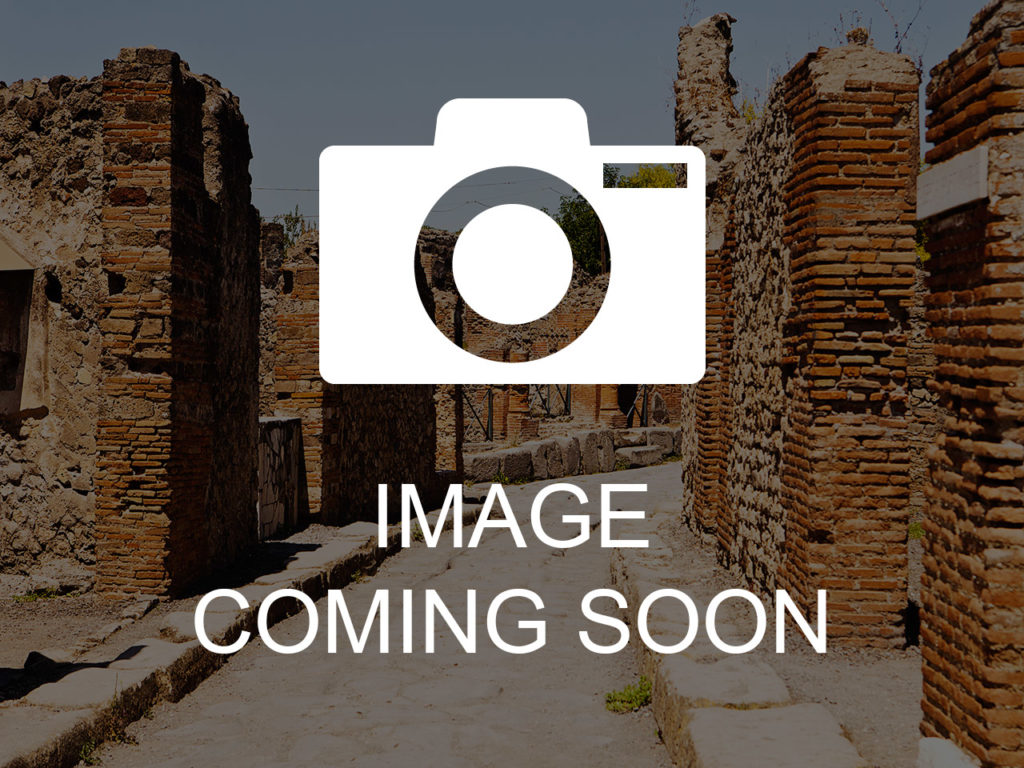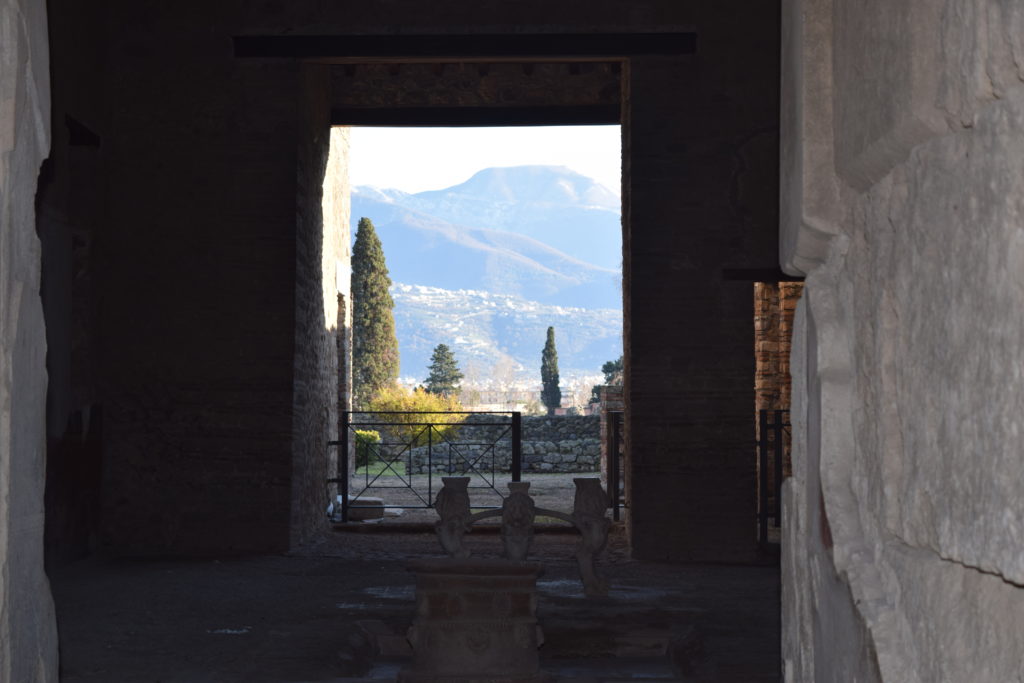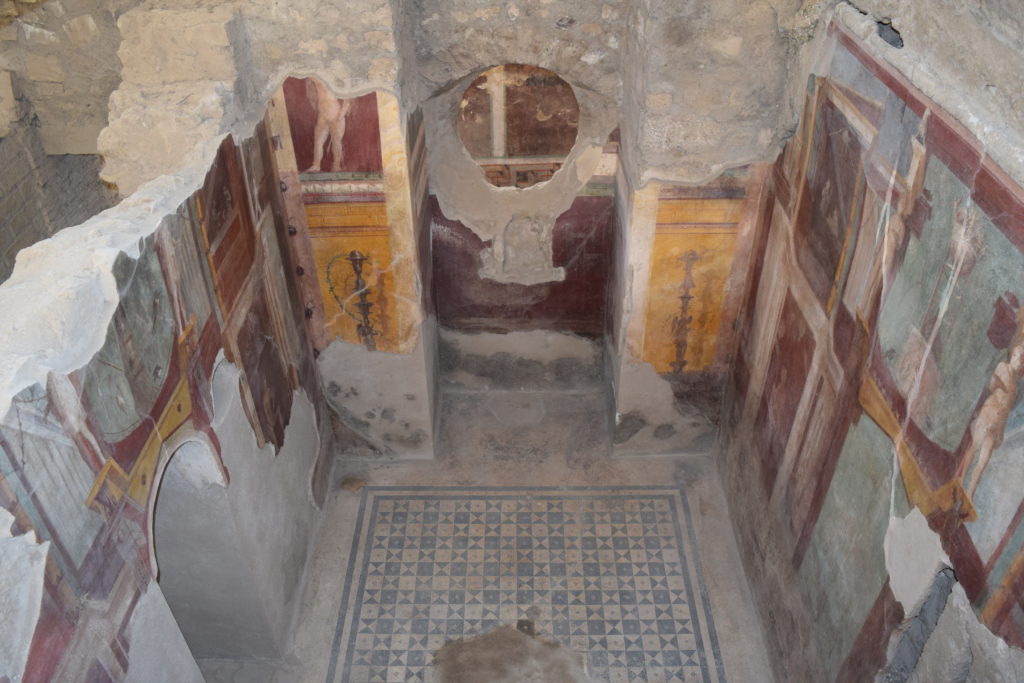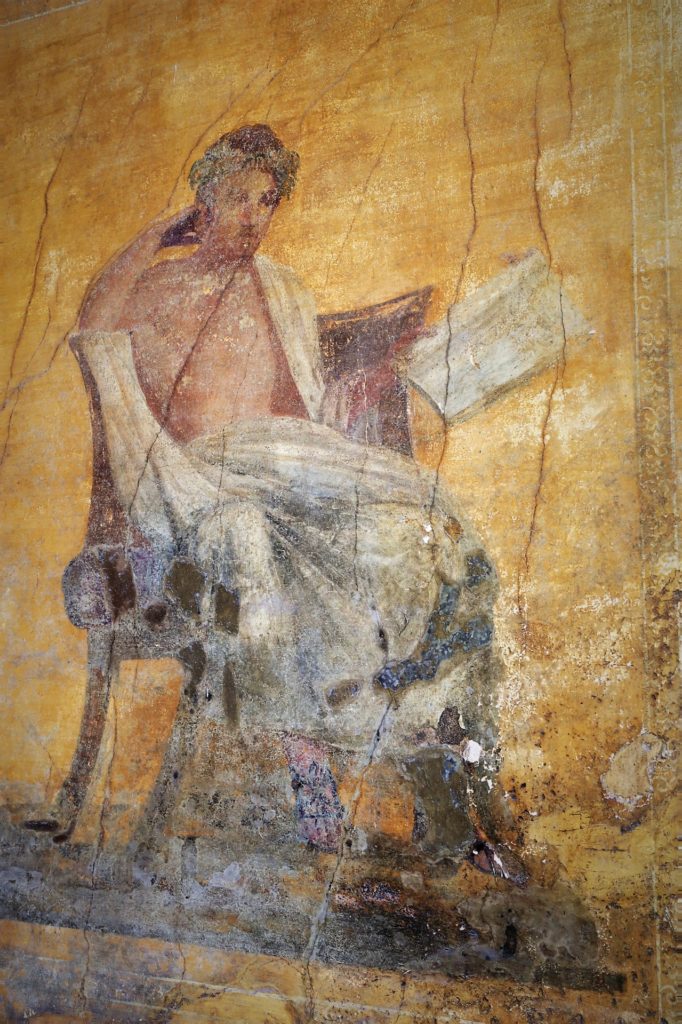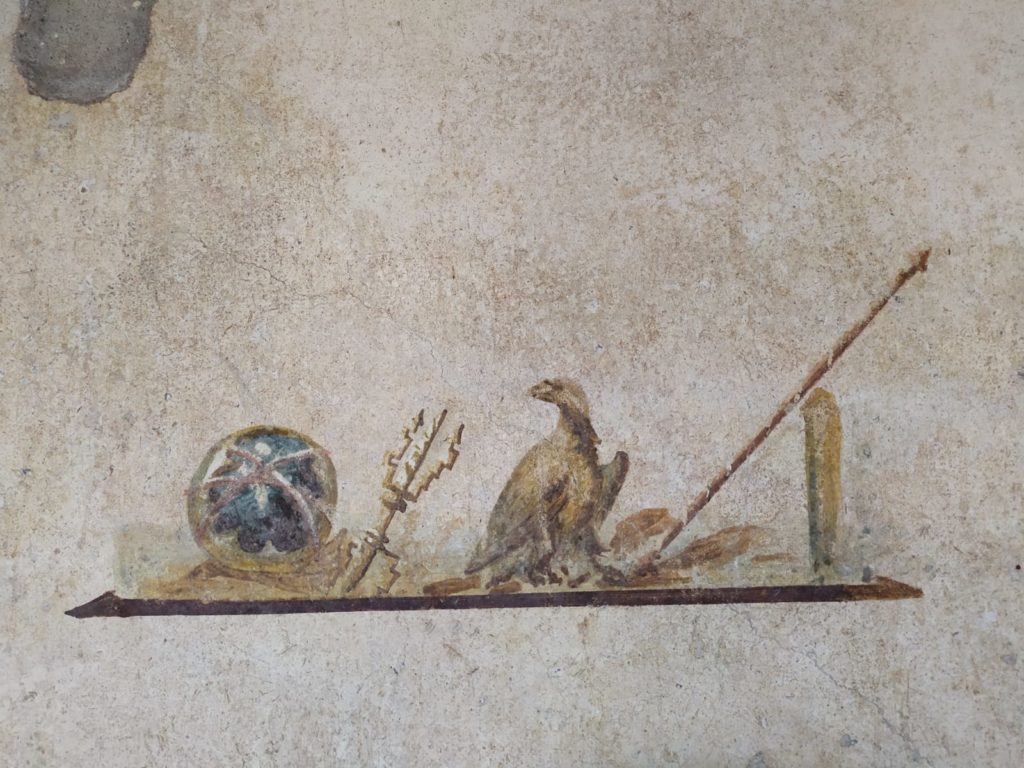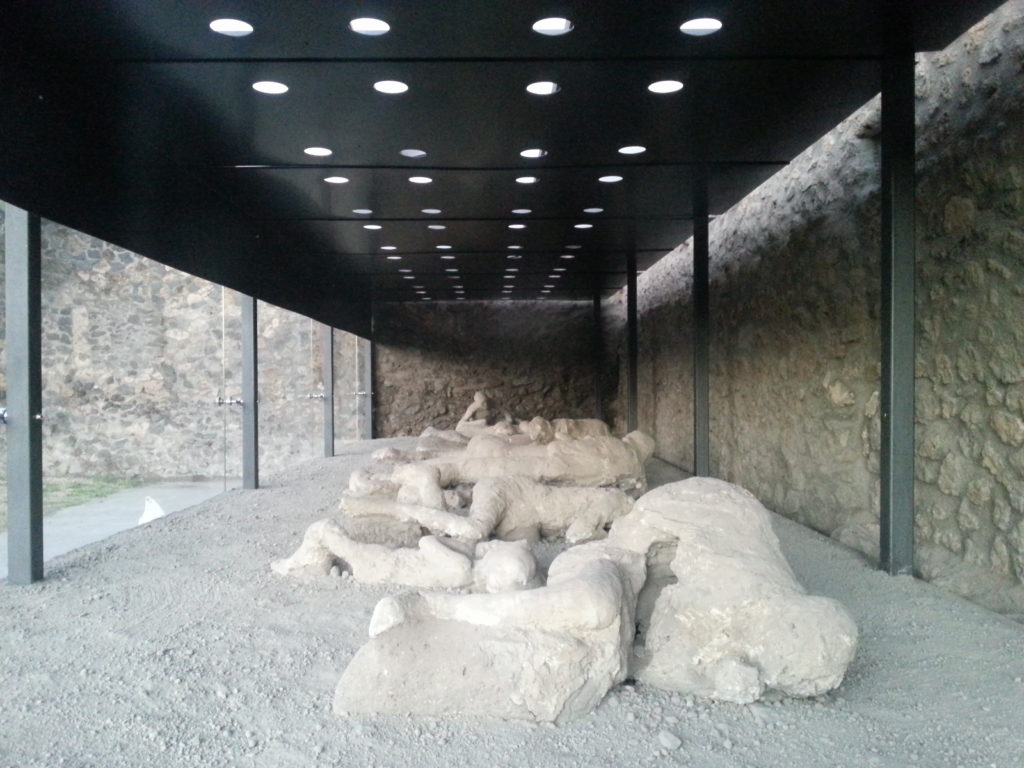Map
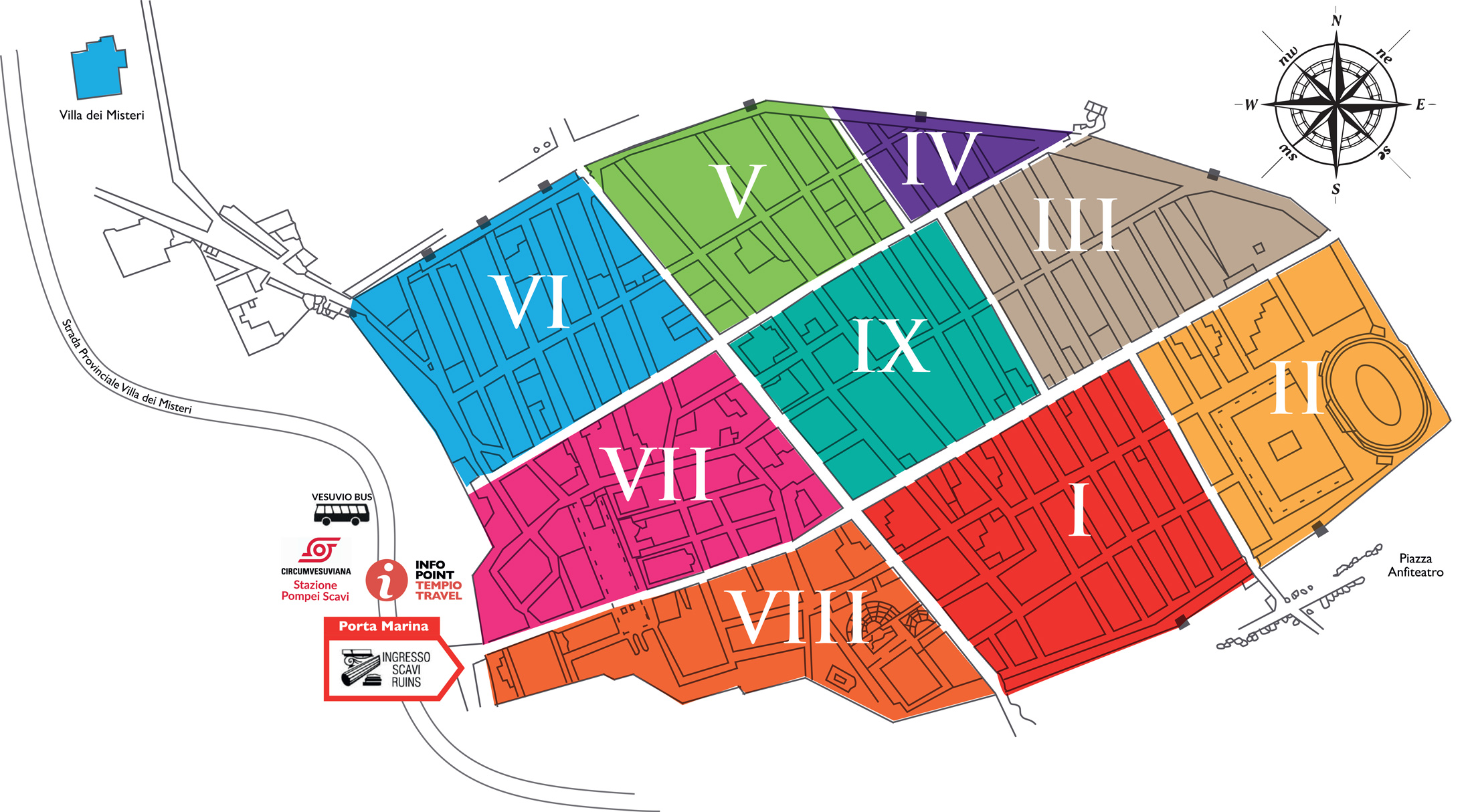
REGIO VII
REGIO I
REGIO II
REGIO III
REGIO IV
REGIO V
REGIO VI
REGIO VIII
REGIO IX
REGIO I
House of Citharist
The house of the citharist is one of the pompeii’s largest aristocratic houses, created by joining two houses together. The house was initially excavated between 1853 and 1861 and again in 1868, 1872 and 1929.
The fauces opens off the south side of the via dell’abbondanza onto a rectangular atrium with a central impluvium and puteal.
In the centre of the peristyle is a rectangular garden with a large piscina near which was found a bronze group featuring a boar being attacked by dogs. A copy of the statue group is on display while the original statue group, like the statue of Apollo Citharoedus, can be viewed in the National Archaeological Museum of Naples.
In this peristyle was found the statue of Apollo Citharoedus, after which the house was named.
House of Casca Longus
The House of P. Casca Longus, which is situated on the Via dell’ Abbondanza, is also known as the Casa dei Quadretti Teatrali. The house was first excavated in 1927 and derives its name from an inscription on a marble table tripod found in the neighbouring garden. The legs consist of a lion’s foot topped with a lion’s head with a square cap to support the marble table top. On the top of one of the legs is the legend PUBLIUS) CASCA LONGINUS, one of the conspirators who killed Caesar in 44 B. C.
The fauces leads directly to a large rectangular atrium with rooms off three sides. In the centre of the atrium is an impluvium the base of which is decorated with coloured marbles.
The atrium itself is decorated in the third style with blue panels where are several small square theatrical scenes inspired by the tragedies of menander..
The impluvium lies directly underneath its counterpart in the roof, the compluvium, which has recently been restored complete with its rainwater spouts.
Fullonica Of Stephanus
The Fullonica of Stephanus excavated in 1912, is the only laundry in Pompeii that had not simply been adapted from an existing building, but was a full restructuring of a patrician house, rationally laid out to best fulfill its new function. The name of the probable owner, a man named Stephanus, was deduced from election propaganda painted near the entrance which also inform us that women as well as men worked therein. Both the final phase in the preparation of fabrics, the end process for removing the last traces of dirt, as well as the public service of washing and pressing garments took place in the fullonica. The atrium is dominated by the central impluvium which has been transformed into a tub for washing by the addition of a raised surround.The peristyle with its small central garden gave access to the triclinium and the main laundry facilities; three large tubs, interconnecting but without a drainage system, and five oval basins where the workers washed the fabric by trampling on it after having soaked it in a mixture of water and a degreasing agent such as soda and human or animal urine. Off the south west corner of the peristyle is a small kitchen with a masonry hearth and a covered latrine.
House Of The Lararium
The House of the Lararium is also known as the House of the Lararium of Achilles as well as the House of the Ilion Sanctuary. The house was first excavated between 1912 and 1913 and derives its name from a small room in the south west corner of the atrium referred to as the ‘Lararium’. Together with the House of the Cryptoporticus it was once part of a much larger property which was subdivided, probably after the earthquake of 62AD. The vault and upper parts of the wall of the atrium are stuccoed and painted in the fourth style with scenes from the Iliad showing figures, in relief enacting the final episodes of the Trojan war. In the north west corner of the courtyard is a flight of stairs to the upper floor. In the courtyard were found piles of building material along the east wall as well as under the stairs.
Off the north east corner of the courtyard is the service consisting of the kitchen.
House Of Cryptoporticus
The House of the Cryptoporticus excavated in the period 1911-29, once formed part of a much larger property belonging to the Valerii Rufi family. This house, which must have been one of the largest in Pompeii, was divided in two, probably just after the earthquake of 62AD. In one, the grand cryptoporticus, with its luxurious baths, was reduced to a warehouse; in the other (the House of the Lararium), the elegant ‘Room of the Elephants’ that once opened onto a broad loggia overlooking a large garden became the rear room of a much smaller house.
The decoration of the lararium shows a large serpent raising its head towards a bust of Mercury set in an arched niche above a projecting ledge. Under the niche is a second snake coiled round a small altar. In the background are a variety of plants and bird life including a rather splendid peacock.
Opening off the east wing of the cryptoporticus is a baths complex.
The decorative theme of the triclinium is a repeat of that of the cryptoporticus, the herms and caryatids here becoming half busts supporting the fine cornice which is embellished with corbels in the shape of bulls in relief.
House Of Ceii
The house of the Ceii is also known under two other titles – the House of L. Ceius Secundus whose name is mentioned in a campaign message painted on the house’s facade and also as the House of Fabia and Tyrannus. The house was excavated between May 1913 and August 1914.
The walls of the garden area are decorated in the fourth style above a lower decorative red frieze featuring plants and bird life. There is a large hunt scene painted on the north wall
The east and west walls of the garden area carry Egyptian landscapes featuring pygmies, hippopotami, crocodiles and Egyptian style buildings, all with red or yellow borders containing decorative elements.
House Of Menander
The House of Menander lies on the south side of the Vicolo del Menandro. A ring seal found in the servant’s quarters suggest that the property was owned by Quintus Poppaeus, possibly a relative of Poppea Sabina, the second wife of the Emperor Nero. The house is so called after a painting of the Greek playwright Menander found in a niche at the back of the peristyle.
The house, excavated between 1926 and 1932, was built in the 3rd century BC and was considerably added to and altered many times over its history.
In the north west corner of the atrium is a temple style lararium
which was decorated in the fourth style with a single imitation marble column.
In the peristilium there a second lararium and the baths under those were found over 100 pieces of silver, including a group of silver pouring and drinking vessels wrapped in heavy cloth, silver utensils, 2 silver mirrors and the remains of a portable silvered table. Some of the silverware found is pictured opposite.
House Of Paquius Proculus
The House of Paquius Proculus was excavated in 1911 and again between 1923 and 1926. It is a relatively small building, but it does possess a large peristyle and some fine decorative details.
The house derives its name from one of several election inscriptions posted on either side of the entrance. The house is also known as the House of Cuspius Pansa from graffiti found on the west side of the fauces.
The fauces opens onto the atrium, the floor of which is literally covered with mosaic panels of animals framed with decorative borders
The garden in the centre of the peristyle contained the summer triclinium which was shaded by a pergola supported by four columns.
House Of Hephebus
The House of the Ephebus, also known as the House of P. Cornelius Tages, takes its name from the statue of the ephebus (a bronze copy of a Greek work of the 5th century BC) found there.
It probably belonged to Publius Cornelius Tages, a wine merchant at that time. It was excavated between 1912 and 1925.
It is a very large property occupying a large part of the east side of Insula 7. The house is sumptuous both in terms of its design, consisting as it does of three houses merged into one, and in its decoration, which is mainly in the fourth style.
Inside the bricked up entrance is a cast of the original doors which were firmly barred and bolted at the time of the eruption
On the south side of the atrium an opening leads through to a second atrium which has the remains of a central impluvium.
House And Thermopolium Of Venutius Placidus
The thermopolium and house of Vetutius Placidus are closely linked. The bar area, which served both food and drink, opens directly onto the south side of the Via dell’Abbondanza. The marble counter has jars inset into the worktop which were used to hold food – during excavation work one of these dolia was found to hold a large quantity of coins to the value of about 585 sesterces, perhaps stashed for safe keeping until the eruption subsided. A stove, positioned on the counter facing the eastern wall, was intended for heating food.
To the right of the entrance is the base of a flight of stairs. On the rear wall of the bar, between the two doorways, is a painted lararium which is embellished with some fine stucco work. In the scene the central figure (the Genius of the household) is performing a sacrifice over a small folding altar. On the far left side is Mercury, the god of commerce, while on the far right stands Bacchus, the god of wine.
The house is decoreted with frescoes adorned with mythological scenes.
House Of Orchad
This house, excavated between 1913 and 1951, is also known as the House of Euplia and the House of the Floral Cubicula. The last house on the block, it is a small but elegant home. At the entrance to the house is a cast of the original wooden door. Also visible is a view of the atrium through the entrance to the adjoining shop.
The house follows the standard atrium/garden plan.
The decoration, which is typical of the first century AD, consists of garden scenes against a blue background with rich bird life, flowering shrubs, statues and fountains beyond a pergola decorated with scenic plaques displaying Egyptian motifs.
House Of The Europa Ship
The house was first excavated between 1951 and 1961 and again in 1972, 1973 and finally 1975. The house is so called after a grafitto drawn on the north side of the peristyle depicting a cargo ship and its life-boat, with the inscription ‘Europa’. The name alludes to the Greek heroine kidnapped at sea by Jupiter.
Immediately west of the fauces is a room in which is displayed an olive crusher. The olive crusher was designed to separate the pulp of the olives from the stones, which were thought to impair the flavour of the oil produced.
During excavations in the garden late last century roots from a vegetable garden and orchard were uncovered. The plants grown included beans, onions and cabbage, grapes, cherries, peaches and lemons, which were held in high regard for their medicinal qualities.
Seeds and seedlings from some exotic plants were kept in 28 terra-cotta vases found along the boundary wall. It would also seem that animals were raised in stalls at the back of the garden.
Garden Of Fugitives
Inside the city, just west of the gate, is the so called ‘Garden of the Fugitives’ where a number of bodies , 13 victims, were found during excavations. Judging by the plaster casts they would seem to be a family group, adults and children. .They were probably trying to flee the city when they were overcome by the sixth and final pyroclastic surge which swept though Pompeii at about 8am on the morning of the 25th of August. Thank to the plaster cast technique it is possible to see the shapes of their bodies, their clothes and their expressions a moment before death took them.
The area, at the time a vineyard, was excavated between 1961 and 1974.
